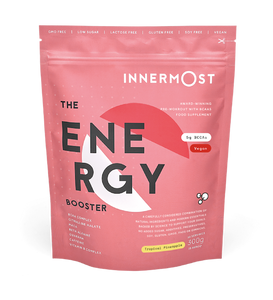We all live busy lifestyles, so preparing and planning lunch may not take priority; it can often come as an afterthought and it’s very easy to just pop to the shop and grab something quick. Those meal deals are oh so tempting. But not only is this an expensive way to have your lunch but also very unsustainable. We’ve put a list of the 10 best ways to make your lunch more sustainable - so you can save money and the planet, win win!
- Cook from Scratch
Forget that supermarket meal deal, they are expensive and covered in single use packaging that’s usually not recyclable. Cooking from scratch is not only cheaper and more sustainable but it’s healthier too. You can do your future self a favour by batch cooking at the weekend. Try creating a meal prep plan, with which foods you want to cook and eat for each day in the week. Once you’ve cooked all your meals you can store in reusable containers and either refrigerate or freeze.
If you aren’t a big eater, overnight oats are a good way to get your protein in, try adding our health protein powder in for the extra boost for your immune system. These are quick and easy to make and fill you with enough energy to tackle the day ahead.
- Use a Reusable Lunchbox
The first step to a more sustainable lunch is your lunch box, you want something you can reuse again and again, that keeps your food fresh, together and protected. The last thing you need is a squished sandwich, right?
Try to avoid using thin plastic boxes they can easily stain, crack, and end up smelling a bit gross. A great alternative to plastic is a metal container. These are really strong, and come in a great variety of options, including separated sections to keep your food apart.
Or if a metal box isn’t your style there are some wonderful glass lunch containers that are ideal if you are batch cooking and need something that will take hot food. If your making hot food the morning before, thermos insulated reusable containers keep your food hot throughout the day so you can enjoy something warm if you don’t have the facilities to heat up food at work.
Check what containers you have in your house. There’s more than one use for everything so keep your mind open to options, for example once you’ve used up a jam jar this can be a great vessel for layered salads or overnight oats.
- Avoid using clingfilm or tinfoil
If you don’t have a segregated lunch box but still want to keep your sandwich separate from everything else, you can try reusable wrapping. Avoid using clingfilm and tinfoil where possible as they are only single use. Bees wax coated fabric is an efficient way to keep your sandwich separate and protected. Its washable and made from natural products. They also come in a variety of fun designs.
Reusable paper bags are an efficient alternative to waxed fabric, they are super affordable and compostable or recyclable. Sometimes it might not be possible to use reusable items, so when you do find yourself using a single use product make sure to recycle it correctly to be more sustainable.
- Invest in a reusable water bottle
If you have a kitchen at work, you may be lucky enough to have glasses available for your water. However, this isn’t available in some workplaces, so investing in a reusable water bottle will help to reduce the amount of plastic disposable bottles you use.
There are many different options to choose from, try a glass bottle for something easy to put in the dishwater or a metal insulated bottle to keep you water cool in the heat.
- Buy food locally
Buying local food is a fantastic way to support smaller businesses as well as reducing your carbon footprint. If you have any farm shops locally these are great places to buy your fruit, veg and meat. Local butchers are also a great for any meats and pies.
If you are buying from supermarkets, check where your products origin is. Avoid buying things from other countries as the air-miles it takes to get the products shipped to the UK are not good for your carbon footprint.
Waste free pantries are popping up all over the UK, where you can bring you own containers in and choose from a range of different foods, including pasta, flour, and oats.
- Eat seasonally
Try to incorporate a low carbon footprint diet. Just like buying locally, eating seasonally reduces your carbon footprint. Making sure your only eating fruit and veg that is in season, this will ensure a good balance and variety into your diet throughout the year.
It also means you’ll be buying fruit and veg from the UK when it can be grown here rather than when it’s out of season and having to ship it in, for example strawberries. Only eat strawberries in the summer when they are grown in the UK and when we transition into autumn switch to using autumnal fruits such as blackberries and rhubarb.
- Eat sustainable foods
There are certain foods that you really should avoid eating if you want to be more sustainable. We hate to break it to you but avocado? Its an ava-no-go. Did you know it takes more water to produce 11 avocados than a lithium battery for a Tesla? In other words, they use up way too much water. Not only this but they aren’t commonly grown in the UK meaning high air-miles. They have also been linked to deforestation. All round they are just not sustainable.
The same is said for palm oil products. Palm oil plays a big part in deforestation and the destruction of many ecosystems, so try to cut down on using products that have palm oil in… unfortunately that does mean saying goodbye to products like Nutella, however there are some fantastic alternatives without palm oil such as the Gu hazelnut spread. By cutting down you reduce the level of destruction from palm oil production without completely taking it away from the smaller communities that may rely on the production for a living.
- Waste less food
The UK wastes a shocking 9.5 million tonnes of food each year. 70% of that is food intended for human consumption (30% accounts for inedible bits such as chicken bones). We can do a lot to help bring this down. If you find you are leaving part of your meal, try to save it for later rather than throwing it away. If this happens often, cook smaller portions so you end up with no waste.
Get creative, some foods may seem inedible but can be delicious. Have you tried banana skin bacon? Don’t forget about the famous bubble and squeak, a traditional British dish using leftover roast vegetables.
- Compost waste
Sometime waste can’t be helped. Not everyone likes the crusts on a sandwich or slimy salad leaves. But instead of putting it all in the bin and sending it to landfill, use your home compost for biodegradable food waste. This adds nutrients back into the soil and improves our ecosystem.
If you live locally to a farm, and don’t have anywhere to compost your food, they might have a use for your waste food, chickens and pigs love to eat old scraps of food. This a great way to put your waste back into the food chain.
- Eat at sustainable restaurants
We know that making your lunch every day may not be possible, you might be meeting friends and eating out, or having a work meeting at lunch in a restaurant. But you can still make your trip a sustainable one by choosing your restaurants carefully.
Thankfully with sustainability becoming more of a daily routine than a myth, there has been a rise of zero waste restaurants. Many more businesses are striving to make meals using more sustainable seasonal food as well as reusing food that previously may have been wasted.
The Sustainable Restaurant Association is working together with different businesses in the food sector to drive sustainability in hospitality with their Food Made Good programme.
Now you have all the knowledge you need to be more sustainable in your lunch, why stop there? There are so many ways you can be sustainable in your life, from training more sustainably to wearing more second-hand clothes. The possibilities are endless, together we can make a more sustainable future. Keep up the good work!



















